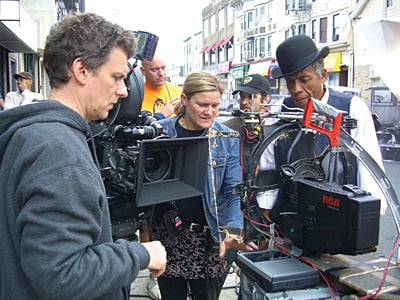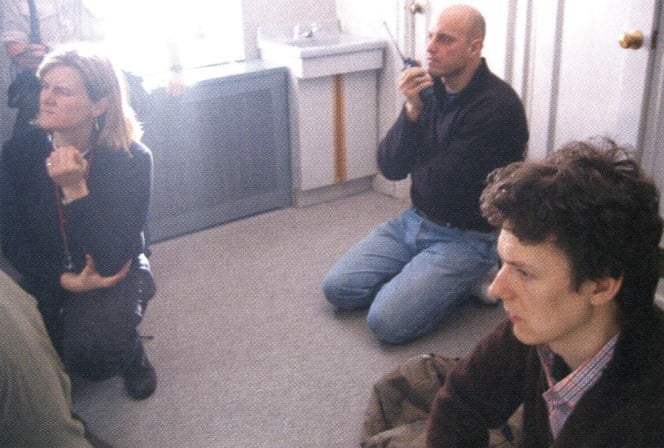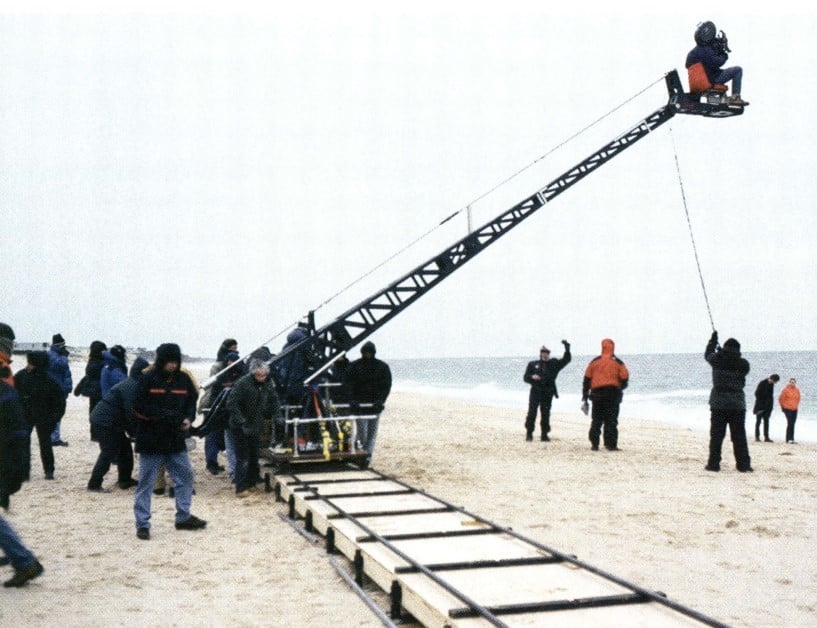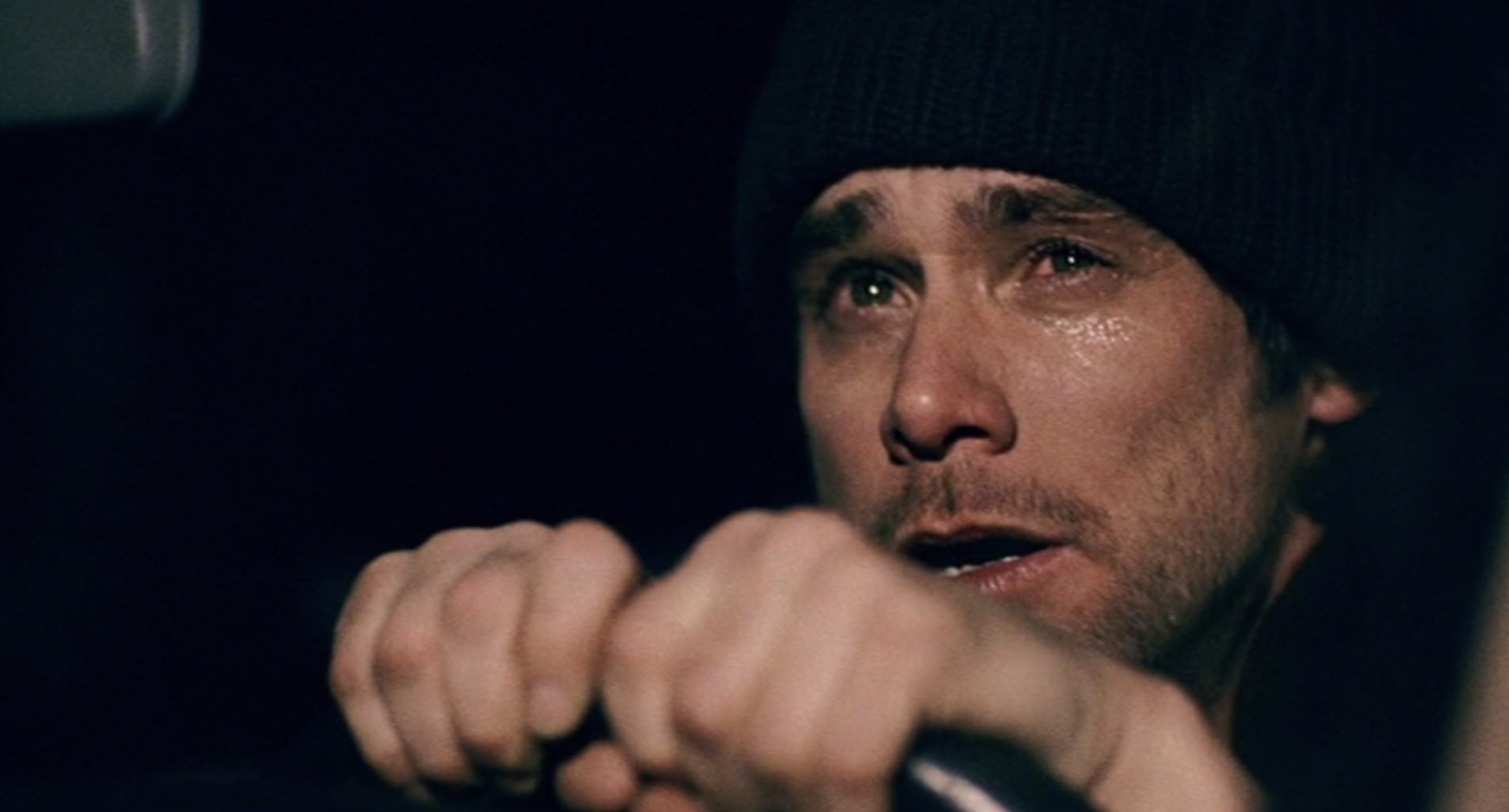
Forget Me Not: Eternal Sunshine of the Spotless Mind
Shot by Ellen Kuras, ASC and directed by Michel Gondry, this innovative tragicomicdrama explores a man’s fight to retain his romantic memories.
By John Pavlus
Unit photography by David Lee
The plots of screenwriter Charlie Kaufman’s bizarre movies (Being John Malkovich, Adaptation) have always defied easy description. Thus, it might be surprising to some that his latest tale, Eternal Sunshine of the Spotless Mind, follows the universally familiar romantic pattern of “boy meets girl, boy loses girl” — that is, until the point in the story where “boy arranges to have all memory of girl erased.”
Eternal Sunshine tells the tragicomic story of Joel (Jim Carrey) and Clementine (Kate Winslet), a loving yet hopelessly mismatched couple who, after breaking up, decide to have their painful memories of each other permanently removed. Providing this dubious treatment is Lacuna Inc., whose funky young technicians identify and delete their clients’ troublesome recollections. But when Joel accidentally becomes lucid during the procedure and begins to surreally re-experience all of his vivid moments with Clementine, he realizes he has made a grievous mistake, and struggles to mentally preserve the remaining details of his bittersweet love affair.

The film’s director of photography, Ellen Kuras, ASC, notes that director Michel Gondry, whose acclaimed music videos “often deal with the morphing of time and space,” was ideally suited to visualize a story whose primary setting is the boundless realm of its protagonist’s memory. However, Gondry was eager to depart from the hermetic, studio-bound experience he’d had on a previous Kaufman project, Human Nature. With its slippery shifts between reality and distorted memories, Eternal Sunshine required a look that could blend location shoot authenticity with unpredictable flashes of whimsy. Kuras, whose own work often strikes a balance between raw and stylized imagery (notably on Summer of Sam; see AC June ’99) proved a perfect match.
The cinematographer soon discovered just how challenging it would be to marry the two halves of Gondry’s vision. “Starting off, he wanted to shoot the entire movie in practical locations, and he would have preferred me to shoot everything in available light,” says Kuras. “He felt that the more real the film looked, the more you would believe it when the memories melted into reality. It was important for him not to get overburdened by the lighting, which I agree with in theory. But in practice, you have to be able to light so the camera assistants have a stop to work with to get the movie in focus! I said, ‘Michel, even on a documentary, I wouldn’t shoot exclusively with available light.’”

But running parallel to the director’s desire for naturalism were his decidedly “unnatural” ideas for the film’s transitions between reality and memory. “Much of the syntax of the dramatic action leads you to believe that you’re in a memory, or a memory of a memory, but the reality of where you are in time and space is not exactly clear,” Kuras explains. “One of the ways Michel wanted to suggest this visually was by calling back to early cinema, where magicians were using live-action practical effects in order to change time and space. He didn’t want them to feel or look completely seamless. In one of the scenes, he wanted me to shake the camera so we could see it was a handheld effect in camera, as opposed to a locked-off superimposition effect or double exposure. That was the enigma of the film to me: we would have these unconventional, trompe I’oeil transitions that were not transparent film language, but the lighting sources had to be naturalistic at the same time.”
Kuras and Gondry used most of their six-week prep to determine the feasibility of these ideas, as well as scout locations in and around New York City for the wintertime shoot — “one of the coldest winters on record,” Kuras recalls. Although most of the picture was filmed in practical locations, the filmmakers knew that some studio work was unavoidable. “We always had two cameras running, so it was impossible to do some of these effects [in a practical location] because there wasn’t enough room,” says Kuras. Production designer Dan Leigh recreated key locations — including Joel’s Yonkers apartment and an oversized, 1950s-style kitchen from Joel’s childhood memories — at a former U.S. Navy base in New Jersey.


Eternal Sunshine was Kuras and Gondry’s first collaboration, and the cinematographer says that the first three weeks of production were devoted to developing a lighting strategy that would combine an extensive use of practical with a handful of movie lights. “On the first day of shooting, I wasn’t allowed to use any real movie lights because Michel wanted me to light to eye,” she says. “For a night exterior, for example, I had to clip some sodium vapors onto telephone poles to augment the existing sodium vapors. On stage, Michel wanted to recreate the conditions we had encountered on location. After they’d built Joel’s apartment set, Dan [Leigh] pulled me aside and said, All of the ceilings have been nailed down, so you won’t be able to light from above.’ That made me laugh — the last nail in my coffin!”
Complicating matters further was the fact that two handheld cameras were filming near-360-degree coverage most of the time. “There were no marks and very few rehearsals, so we didn’t have any kind of gauge for where the actors would be,” recalls Kuras. “Ultimately, that meant we were lighting the room, not the actors. Sometimes they were in the key light, and sometimes not. If I knew where the actors were going to be, I’d try to put something in, but it wasn’t as though we had electricians hanging around with Chimeras for beauty lights. Although I understood the kind of movie Michel wanted to make and tried to give him what he wanted, there were moments when the cinematographer in me just cringed, especially when the actors danced in each other’s key light. In one scene, when Clementine brings Joel to her apartment for the first time, we had two cameras covering the scene from start to finish, and because we were seeing the entire room, I had to use the practical lamps as the only source of key light; I couldn’t get any other kind of ancillary light low enough to look natural. We ended up cutting holes in the lampshades and hiding light bulbs around the set to illuminate the scene. Unfortunately, what happens in this situation — and what happened in this scene — is that one actor ends up shadowing the other.”

Throughout the shoot, Kuras and her longtime gaffer, John Nadeau, strove to jerry-rig units that would provide ample illumination but would also fly under Gondry’s definition of a “film light.” Kuras explains, “We had different assortments of lightbulbs — refrigerator bulbs, or small bulbs on hand dimmers — that we’d hide behind furniture or lampshades in order to give ourselves some stop. In Joel’s apartment, we fabricated a light we jokingly called the ‘Mini-Musco,’ which was essentially a C-stand with four clip lights and blackwrap on it. We ended up lighting all the interiors with either available practical or those clip lights, which had 150-, 250- or 500-watt bulbs. It was a game of hide-and-seek, determining how and where we could hide our little kit of light bulbs.
“One might ask why I was lighting the entire room rather than the actors,” she continues, “and it was because the two cameras shooting simultaneously were moving in the room according to Michel’s instructions. He had both operators [listening] on ear rigs, through which he would extemporaneously ask them to pan or move into a close-up. I must admit, we were less than enthusiastic about the ear rigs.”
To help the actors maintain the flow of a scene, Gondry often shot entire scenes from beginning to end. Covering the scenes in dual moving master shots while keeping the opposing camera out of frame demanded spontaneous choreography by A-camera operator Chris Norr and B-camera operator Peter Agliata — and plenty of 400' mags. An 11-page scene that depicts Joel and Clementine’s first meeting on Montauk was especially arduous, according to Kuras. “We were shooting on a real moving train on real tracks, and we only had a certain amount of time to get the scene. We had to use 1,000' mags to cover the scene in a oneshot deal, which is a killer way of shooting because you always have to be ‘on.’ While rolling, Michel would often ask us to move the angle of the shot. We didn’t know whether he would use these shots as one move, so we tried to make everything usable. With all of that shifting, squatting and standing, working with the weight of 1,000' mags, and trying to slip between train seats with the assistant holding focus, the camera movement is not always the most graceful.” With a laugh, she adds, “In the final cut, not surprisingly, Michel doesn’t use any of the moves.”


film an exterior sequence.
Inspired by the French New Wave, the filmmakers used some unusual methods to accomplish many camera moves. “Michel was very interested in calling back to Godard, whose work I know very well, by having us handhold the camera while sitting in a wheelchair,” says Kuras. “My key grip, Bob Andres, and I did all these tests that had me in a wheelchair or in a chariot dolly, running all over sidewalks and up and down curbs, to see how bad it would be, especially on cobblestone streets. The wheelchair dolly move wasn’t always perfectly smooth, but there was often real beauty in that low-angle, wobbly movement, and I was willing to go with it. With the entire film shot handheld, we ended up using sled dollies, wheelchairs and chariot dollies, but no traditional dollies at all.”
Occasionally the overlapping demands of long takes, naturalistic lighting and cramped locations resulted in a downright comical configuration behind the camera. For instance, instead of staging a car scene with a process trailer, Kuras, Norr, two cameras and one assistant squeezed into the rear passenger seat to film both angles of a scene in which Carrey drives a car for real and Winslet rides along. The bulky mags required for the long take wouldn’t fit inside the car, so the crew hung them out the windows, which then had to be boxed in for sound. “But as usual, we were shooting with only available light,” says Kuras, “so we had to build a tiny muslin-and-Plexiglas exterior [for the mags], or we would have been totally dark in the back. And of course, the car wasn’t a Lincoln Continental with four doors, it was a tiny Toyota! [First AC] Carlos Guerra was sitting between the two cameras, pulling focus on both at the same time. Talk about going in the completely opposite direction of a studio picture!”

operator Peter Agliata and Kuras film dual master
shots, a
technique employed throughout the shoot. Right: Kuras and first AC Carlos Guerra prepare for
one of the film's numerous long takes.

Sunshine was
shot entirely
handheld, and
Kuras and her
crew strove to
achieve unusual
moves with a
variety of
equipment. A
traditional
camera dolly
was never used.
However, Kuras was able to stylize a sequence she refers to as “the chase scene.” As Joel burrows deeper into his own memories in a vain attempt to “hide” what remains of Clementine from the Lacuna technicians, the scenes’ quality of light becomes distinctly dramatic. “We didn’t want to make it a huge departure from the film’s look, but we wanted to signal to the audience that we were in the tunnel of the mind,” Kuras explains. “Michel’s visual analogy, which was brilliant, was inspired by the French film Le Boucher: a car is driving on a deserted country road at night, and you can only see what’s illuminated by the throw of the headlights. When you’re remembering something, you don’t get a full picture; you only see certain glimpses of the scene in your head, depending on what you’re focusing on. So, for our ‘memory light,’ we attached a single clip light on top of the camera for closer shots; we used a Par can to similar effect in the wide shots.”
Kuras filmed Eternal Sunshine on Fuji Reala 500D, mainly because she liked its cyan bias in the shadow areas and the smoothness and saturation of the colors and grain. “Although cyan in the blacks is perhaps not ‘traditionally accepted,’ I actually built additional cyan into the shadows at the post stage, because I really liked the look and color palette created by warm sodium-vapor yellow in conjunction with cyan green and cyan blue,” she says. She made maximum use of the Reala by pushing it one stop and eschewing correction filters on her Zeiss Superspeed lenses.
At some key moments, the filmmakers simply let the frame go dark. “Michel really wanted this to feel like a European film, and many of those have shots where everything is dark and you can only glimpse one thing in the frame,” says Kuras. “I admire the way Nestor Almendros [ASC] used available light, and the way Robby Müller still does. They and Raoul Coutard are some of the most amazing cinematographers. They use light sparingly, and I ascribed to that [approach] on this film.”

The filmmakers’ straddle between frank naturalism and visual metaphor didn’t stop when Eternal Sunshine wrapped. Indeed, when Kuras and Gondry first began to work out the details of Eternal Sunshine, they decided to finish the film with a digital intermediate (DI). Kuras had used the process on two prior projects, Spike Lee’s Jim Brown: All-American (Post Process, AC Sept. ’02) and Rebecca Miller’s Personal Velocity (AC April ’02). On Jim Brown, Kuras used the DI to provide a high-quality blowup on a short schedule; on Personal Velocity, she used it to sweeten her original DV footage into something more “filmic.” She notes that there were a number of reasons, both creative and logistical, for taking Eternal Sunshine to a DI. The most salient was Gondry’s desire to insert digital composite effects throughout the film; the DI process would allow Kuras more flexibility in matching the effects shots with images scanned from the original negative. But the cinematographer was also keen to make the most of digital tools’ abilities to affect select areas of the frame: “I knew the DI would enable me to influence colors in the highlight and shadow areas within the image itself, which you can’t do in traditional timing. Power Windows afford a great amount of control.”

For the color-correction, Kuras returned to EFilm in Hollywood, where she had supervised the DV-to-35mm transfer on Personal Velocity. “[Postproduction coordinator] Mike Kennedy and [colorist] Mike Eaves at EFilm and [vice president] Beverly Wood at Deluxe all bent over backward to help me realize the unique vision of this picture,” she notes. “With changing film stocks and different goals for each film, the DI process is a new learning experience each time.”
Before production commenced on Eternal Sunshine, Kuras conducted a photochemical color timing test with the Reala stock, and she used that as a reference during the DI. She noted some key differences between color-timing for a DI and photochemical timing that she says will influence how she photographs films from now on. She emphasizes that “timing for a DI is vastly different than timing photochemically.”

For night exteriors and interiors, Kuras had exposed the daylight balanced Reala uncorrected to allow for maximum stop under available light conditions; her photochemical tests had indicated that the resultant yellow cast could be timed out. “It looked really beautiful, and I liked the way the blacks took shape. I’ve never been a huge proponent of blacks being really inky. I don’t want them milky, but I like them to have roundness and, as I said before, sometimes even a bit of color. But what I didn’t foresee was that when we began to take out those 12 points of yellow in the digital realm, we started to pick up video noise.”
Kuras then began to use digital sharpening and grain-reduction tools to reduce the noise. But, she notes, “when you do grain reduction, you’re essentially making the image less sharp.” Working with Eaves, Kuras began creating a series of filmout tests to determine which digital tweaks, with their attendant color shifts and noise consequences, would render the best image. “When I saw the first film out, I said, ‘We can do better. This looks muddy. Let’s try again,”’ says Kuras. “It’s a problem that’s inherent to the DI process, and you have to be careful. I didn’t have that experience on Personal Velocity, but that originated on Mini DV, so it stayed in the digital realm. This was different. You might assume that working with a film original means you immediately have sharpness and clarity [in the digital realm], but you don’t, even if the image is really well exposed. The nature of that image and what color lights you were using — whether you biased it toward the warm side or the cool side — significantly affects the way you perceive the film in a DI. Although I liked the Reala, I did notice that the whites had a tendency to be very grainy in the digital realm, even if the negative was well exposed.”

But Kuras stresses that if one keeps “a vigilant eye,” the sharpness issue is easily managed. “We did our grain reduction in combination with image sharpening,” she adds. “You’d think they’re canceling each other out, but they’re not. The sharpening tool really helped to smooth out the image in a way that I wouldn’t have been able to do photo-chemically, and I was able to make the images a lot more seamless.”

The cinematographer also noted some less obvious differences in color rendition, primarily in the highlight areas, while timing the Eternal Sunshine scans. “In a night interior that I’d lit with tungsten units, I found that the hot spots in the highlights took on a bit of blue, which gave the skin tones a harsher feeling. But it’s a very subtle feeling. I had to wonder whether it was because I was looking at so much tungsten that I felt that blue in the whites, or whether it was actually there.” Kuras found that after subtracting a few points of blue from the highlight zones, the skin tones noticeably softened.
“When Mike and I first started correcting, [I wanted to] stay as close to the scans as possible,” says Kuras. “The scans contain as much information as you’ve got on the negative, and I thought we shouldn’t mess around too much with that because it would be snappier and truer to the image. But because of the digital process, I found little subtleties that were affecting the image, like that rogue blue in the highlights. So in some instances, we altered the look of the film specifically for the DI film out.”
The chief lesson to be learned from any DI, Kuras cautions, is that the process “is not a panacea for all ills. You can’t rely on it to fix certain things you might assume you can fix in post.” She learned this the hard way while timing a scene comprising footage shot in different locations that had been dressed to look identical. “One part was shot in a real location and featured a little boy in a period kitchen, and the other part was shot in an over-sized set of that kitchen and featured Jim Carrey playing the little boy. When we shot the first part on location, I used smoke to haze out the blacks a bit and make it look a little more period.’ Then we shot the oversized set in our so-called stage in New Jersey; it was our last day of shooting, and it would have taken days to smoke up the entire space. If I’d realized how much the smoke was going to influence the matching of the scene, I would have started smoking the warehouse up the weekend before. The lack of smoke posed a problem the DI couldn’t fix. Even decreasing the black levels in the shadow areas didn’t help, because it started making the image look too thin.”
Kuras says these lessons proved invaluable, and a DI is already in the works for her next feature, The Rose and the Snake, which she shot on Super 16mm. “The DI has been a very useful tool for me, regardless of whether the original material was film or video,” she says. “Everybody asks me, ‘What’s the secret? How did you make Personal Velocity look like film?’ But that’s a question more easily posed than answered.”

Eternal Sunshine of the Spotless Mind went on to win Academy Awards for Best Writing and Original Screenplay, as well as nabbing Kate Winslet a nomination for Best Performance by an Actress in a Leading Role. In 2009, the Austin Film Critics Association named it “Movie of the Decade.”






